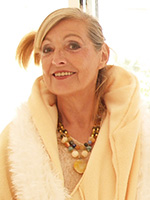Sabine Kahane (Binah Kahana)
 She was born into a family of artists. Her father was a famous book-designer, illustrator and bibliophile, her mother a painter, her uncle an artisan working for the Berlin State Opera. She grew up in Berlin after the war, at a time when the town was split and divided by the wall. As a girl and young woman she lived in the East and was only tangentially influenced by fashionable Western Art.
She was born into a family of artists. Her father was a famous book-designer, illustrator and bibliophile, her mother a painter, her uncle an artisan working for the Berlin State Opera. She grew up in Berlin after the war, at a time when the town was split and divided by the wall. As a girl and young woman she lived in the East and was only tangentially influenced by fashionable Western Art.
Her parents had a tremendous library of some 30 000 books, most of them on art, and were collecting graphics, craftwork, porcelain, jewelry, Asia objects, gems, dolls, toys and whatever, so that she grew up in a kind of museum. Later she visited Berlin’s museums and galleries as often as possible and learned, in addition to her high school degree, the profession of a librarian in the German State Library where she devoured heaps of books about arts and history. Then she studied arts at the East Berlin College of Art and became an artist and book designer.
She illustrated a lot of books in order to earn a living for her two children. The technique she preferred was etching, especially dry point, which she printed herself and colored by hand. She sold her works in East German galleries and completed her advanced studies at the Academy in East Berlin as a master-class student. Among her teachers were the famous Russian graphic artist Orest Vereisky, the Swiss book-designer Jan Tschichold, East Berlin artist Arno Mohr and Chinese painter Li Ting-I. She has worked in all traditional graphic techniques, lithography, etching, aquatint, wood cut and silk-screen-printing. She also painted on silk directly, made ceramics and her first pieces of jewelry.
We met in the late seventies when we both got into troubles with the communist administration in East Berlin. In 1984 we moved to the West, poor refugees, with two small children, some boxes of books and artwork and heads full of ideas. She had exhibitions in Berlin West and other German towns and sold several of her works to help us to get a start, but then decided to keep away from the German market. Instead, she ran a private art school in Stuttgart where we lived for some years, before returning to Berlin and, in 1991, going to Rome, leaving Germany for good.
In the early nineties she worked in Rome and Sperlonga, a small coastal town where earth and strand are sprinkled with pieces of marble and green malachite, remnants of Emperor Tiberius’ ancient seaside villa. It was a place she liked, still inspired by former grandeur, but secluded, in fall and winter abandoned by strangers. The Roman period was a time of studies again, with visits in museums, churches, old palazzi and excavations. We became deeply acquainted with the origins of European art, with antiquities and early Christian culture, and – at the same time – started to go to synagogue habitually and to study the old Jewish books.
In the meantime the children were grown up and did not feel at ease in Germany. For a time the family lived scattered over several countries with an apartment in Berlin and another one in Italy where we met from time to time. We tried to identify with a nomadic existence for a time, but it was she who insisted that even nomads need a homeland, a place to identify with. In 1995 we decided to go to Israel. She fell in love with the desert as soon as she saw it. The southern part of Israel, the Negev, has the dimension she likes: a wide, open space to fill with ideas and imagination. 1997 she moved to the central town of the South, the biblical Beer Sheva, and from there deeper into the desert, to a small settlement next to a famous oasis.
She has been living there since 2000. The small settlement is a centre of desert research where natural scientists, archeologists, anthropologists and linguists live and study. The surrounding landscape is the Zin desert, a Biblical place, described in the Mosaic books. Here the people of Israel ripened from refugee’s existence into settled way of life. It was time also for her, she says, to settle down. Hers is a radiance making decisions fascinating for others. The place she has chosen became the fastest growing community in the Negev desert. There are farms and new settlements being built. Meanwhile, her children and grandchildren do not live far from her. She did here what she had never expected to do: she built a house.
She understands the frontier situation of the desert as a challenge to live up to it, to develop a new kind of style. She was born and has lived in big cities most of her time, comfortable, embedded in Western civilization and laissez fair, but she took the loneliness, the rudeness of climate, the exposed situation of desert life as a new task. During the last years she has started to design her own dresses, scarves, winter-capes, hats, handbags and other necessities, requested by that special kind of life in an open, landlocked space, shaken by wind and storm, flooded with intense light.